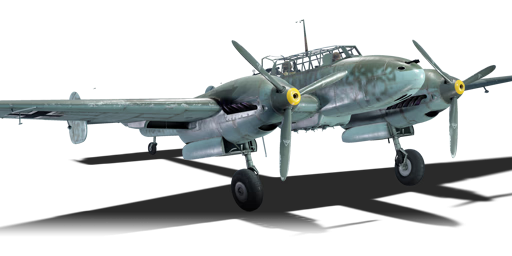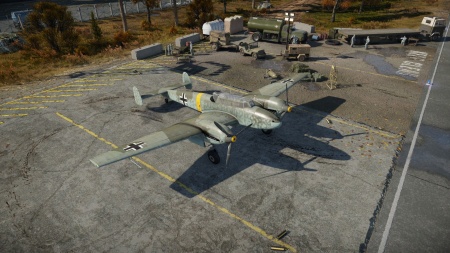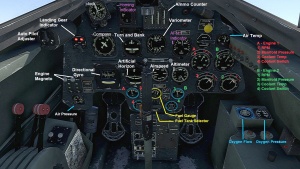Bf 110 C-7
Contents
| This page is about the German twin-engine fighter Bf 110 C-7. For other uses, see Bf 110 (Family). |
Description
The Bf 110 C-7 is a rank II German twin-engine fighter
with a battle rating of 3.0 (AB/SB) and 2.7 (RB). This twin-engine fighter has been in the game since the start of the Open Beta Test prior to Update 1.29. Originally modelled as the Bf 110 C-4, the vehicle was renamed and remodelled into the C-7 in Update 1.79 "Project X".
In game it is one of the fastest aircraft at its battle rating with a speed of 582/560 km/h (arcade and realistic battles as of 1.79) and a BR of 3.0. It packs incredible firepower with 4 x 7.92 mm MG 17s and 2 x 20 mm cannons with a copious 360 rounds all in a centreline mount, a hard-hitting package that will reach out and swat aircraft far away.
The Bf-110 C-7's armament is completely centre-mounted on the front of the fuselage, resulting in little to no-one convergence, and results in a dense fire group. Keep in mind however that the 7.92 mm bullets are somewhat faster and lighter than the 20 mm's fired from the MG FF/M cannons and as such will require slightly less leading. While not much of an issue within close range (approximately <300 m), at a longer distance it will result in the 7.92 mm rounds missing if fired simultaneously with the 20 mm cannon rounds. However, being a pure Boom & Zoom fighter, it is generally recommended to fire both guns when attacking enemies in order to maximize hit probability at close distances when making a high-speed pass.
The MG FF/M 20 mm cannons should generally be considered the BF-110 C-7's primary armament as they will be responsible for the majority of the damage dealt. Careful aiming will only require a few shots with the high explosive shells to disable an engine, blow off a wing or knock out the pilot. It is important to remember that the 20 mm shells have fairly poor ballistic coefficient and tends to drop a lot more than the 7.92 mm's at the same range. Since the 20 mm minengeschoß shells contain a much greater amount of HEI/HEI-T than other belts, their usage significantly enhances damage output. Initially, the ammo pool of 360 rounds may seem low at a first glance, the destructive power of the shells and the MG FF/M's relatively slow rate of fire more than makes up for it.
The nose-mounted MG 17 machine guns are standard and are identical to the ones carried on early war biplanes and early BF-109's. They have a high rate of fire and high precision but a low damage output. Equip either tracers or stealth belts in order to maximize damage output in conjunction with aiming for vulnerable areas on enemy aircraft such as fuel tanks and engines.
The defensive armament consisting of a single MG 15 is effectively useless for the far majority of the time. It will not be able to dish out enough damage, and arguably even worse it will only be able to return fire at chasing planes that fly behind and above the BF-110 C-7. Do not under any circumstance rely on it as an effective means to fend off chasing planes as it's cone of fire is limited and damage output is too weak to make much of an impact most of the time. It is much better to perform evasive manoeuvres and rely on the BF-110 C-7's sturdy airframe in order to make it back to base or allies than for the gunner to shoot the plane down. That being said, there is a chance that the gunner will land a few shots which may take out the chasing pilot or the engine of his aircraft.
General info
Flight Performance
Describe how the aircraft behaves in the air. Maximum speed, manoeuvrability, speed and allowable loads - these are the most important characteristics of the vehicle.
Stat card
| Characteristics | |||||||
|---|---|---|---|---|---|---|---|
| Stock | |||||||
| Max Speed (km/h at 5,000 m) |
Max altitude (meters) |
Turn time (seconds) |
Rate of climb (meters/second) |
Take-off run (meters) | |||
| AB | RB | AB | RB | AB | RB | ||
| 515 | 505 | 10,000 | 32.4 | 33.0 | 7.1 | 8.5 | 444 |
| Upgraded | |||||||
| Max Speed (km/h at 5,000 m) |
Max altitude (meters) |
Turn time (seconds) |
Rate of climb (meters/second) |
Take-off run (meters) | |||
| AB | RB | AB | RB | AB | RB | ||
| 560 | 538 | 10,000 | 29.2 | 30.7 | 16.4 | 11.0 | 444 |
Details
| Features | ||||
|---|---|---|---|---|
| Combat flap | Take-off flap | Landing flap | Air brakes | Arrestor gear |
| ✓ | ✓ | ✓ | X | X |
| Limits | ||||
|---|---|---|---|---|
| Wing-break speed (km/h) |
Gear limit (km/h) |
Combat flap (km/h) |
Max Static G | |
| + | - | |||
| 700 | 320 | 490 | ~11 | ~4 |
| Optimal velocities | |||
|---|---|---|---|
| Ailerons (km/h) |
Rudder (km/h) |
Elevators (km/h) |
Radiator (km/h) |
| < 360 | < 360 | < 400 | > 240 |
| Compressor (RB/SB) | ||
|---|---|---|
| Setting 1 | ||
| Optimal altitude | 100% Engine power | WEP Engine power |
| 3,800 m | 2,100 hp | 2,243 hp |
Engine performance
| Engine | |||||
|---|---|---|---|---|---|
| Engine Name | Number present | ||||
| Daimler-Benz DB-601A 12-cylinder | 2 | ||||
| Engine characteristics | |||||
| Weight (each) | Type | Cooling | |||
| 590 kg | Inline | Water | |||
| Engine power (Stock) | |||||
| Mode | Max | Take-off | |||
| Arcade | 939 hp | 1,009 hp | |||
| Realistic/Simulator | 929 hp | 999 hp | |||
| Engine power (Upgraded) | |||||
| Mode | Max | Take-off | |||
| Arcade | 1,096 hp | 1,166 hp | |||
| Realistic/Simulator | 1,010 hp | 1,080 hp | |||
| WEP Duration | |||
|---|---|---|---|
| Arcade | Realistic/Simulator | ||
| 25 seconds | Infinite | ||
Survivability and armour
Examine the survivability of the aircraft. Note how vulnerable the structure is and how secure the pilot is, whether the fuel tanks are armoured. Describe the armour, if there is any, also mention the vulnerability of other critical aircraft systems.
Armaments
Offensive armament
The Bf 110 C-7 is armed with:
- 2 x 20 mm MG FF/M cannon, chin-mounted (180 rpg = 360 total)
- 4 x 7.92 mm MG 17 machine gun, nose-mounted (1,000 rpg = 4,000 total)
Suspended armament
The options available for the Bf 110 C-7 are:
- 12 x 50 kg SC50JA bombs
- 2 x 250 kg SC250JA bombs
- 1 x 500 kg SC500K bomb
- 2 x 500 kg SC500K bombs
- 1 x 1000 kg SC1000L2 bomb
- 1 x 1000 kg SC1000L2 bomb + 1 x 250 kg SC250JA bomb
Defensive armament
The Bf 110 C-7 is armed with:
- 1 x 7.92 mm MG 15 machine gun, dorsal turret (750 rpg)
Usage in battles
What it cannot do is turn fight, and this is where a lot of players make a fatal mistake. Heavy fighters cannot manoeuvre like a single engine fighter, it has an unusually poor roll rate and loses energy fast, and can unexpectedly snap-roll: rudder control is critical. It is a pure “Boom & Zoom” fighter and like others of its ilk, live by 2 rules: “Speed is Life, Altitude is Life Insurance”, and “Turn to engage (fire at), not follow”. Manoeuvres that retain your energy are key, keep your speed and/or altitude up. The 110 really shines in bomber attack or bomber escort where you will have positional advantage and gun solution first.
When engaging a target only turn to shoot (less than 60-degree turn), the moment you realize you cannot get a firing solution to perform other manoeuvres to keep the advantage. For instance, if your target turns hard, pull up trading airspeed for altitude while watching what your target does. As you slow in climb you can turn tighter (even use flaps briefly) and position yourself for another intercept. If you find yourself under threat, an unloaded extension (slow pushover) can be employed to efficiently gain speed. The Bf 110 can dive very fast to rejoin friendlies if needed. A team with bomber smacking Zerstörers and manoeuvrable fighters will decimate the attacking force in Arcade Battles. If you pick up a tail, just remember to manoeuvre yourself to give your teammate the best chance to taking out your pursuer, and do not count on the gunner.
Modules
When you first purchase the Bf 110 C-7 make sure you research the machine gun and cannon belts first; those are vital for success. Consider tracers ammo for the machine gun and stealth or air targets for the cannon. It is excellent at ground attack as well with guns and bomb selection, but remember that outside of AB, you still start on the ground and have no bombing reticule.
Manual Engine Control
| MEC elements | ||||||
|---|---|---|---|---|---|---|
| Mixer | Pitch | Radiator | Supercharger | Turbocharger | ||
| Oil | Water | Type | ||||
| Not controllable | Controllable Not automatic pitch |
Controllable | Not controllable | Combined | Not controllable | Not controllable |
Pros and cons
Pros:
- Heavy armament consisting of two cannons (MG FF/M) and four machine guns (MG 17s)
- Plenty of ammunition available for the armament, some RB matches you'll finish with <1000 rounds of machine gun ammunition left
- Very manoeuvrable for a twin-engine fighter
- Can carry quite a payload doubling as an attacker or intruder
- 500 kg payload is sufficient to damage and destroy bombing points and other targets
- Exceptionally heavy burst mass for its rank (2.80 kg/s) with large amounts of it consisting of minengeschoß
- Can turn quite well at high speeds
- Extremely deadly opponent at head-ons, never let this aircraft get a good deflection at you
- Sturdy airframe allows for surviving ramming attacks or executing one, though it is generally advised as a last resort
- Climbs generally well, though it cannot match single-engined fighters of its tier, excluding bi-planes
- Tail gunner is hard to hit from a level flight of both the enemy aircraft and the defending aircraft
- Airframe is capable of eating insane amounts of ammunition. It is not uncommon for opponents to empty every round they have into your aircraft not destroy you, even when using cannons
Cons:
- Slow acceleration
- Loses speed easily in turning manoeuvres
- Poor energy retention
- Big target
- Only a single 7.92 mm machine gun as defensive armament with a limited cone of fire
- Elevator is prone to damage, may shear off when hit by cannon rounds
- Flight performance on one engine is very poor and struggles to maintain flight
History
Named the “Zerstörer” (“Destroyer” in English), a very appropriate name for its mission, to destroy anything that is in front of it. In the early days of World War 2 the Bf 110 did very well in roaming wolfpacks, being superior to the opposition in the skies over Poland and France, but that changed drastically in the Battle of Britain. Mounting bomber losses resulted in the fateful decision to force the 110’s to stay very close to bomber formations, losing position and speed advantages over the RAF fighters. Not surprisingly it resulted in a drastic increase in losses. Faced with faster fighters and more manoeuvrable like the Spitfire it was pulled from the front line, only to return in new roles like the “Jabo” fighter bomber and the "Nachtjäger" night fighter. The most successful role of the aircraft was performing night interdiction duties, where its task was to seek out and destroy enemy aircraft, most notably British bombers participating in night raids. In the "Nachtjäger" role, the plane was equipped with FuG 220 and FuG 202 Lichtenstein radar, optionally equipped with a "Schräge Musik" installation consisting of 2 X 20 mm MG FF/M cannons mounted at a 60 degree angle, and a third crewmember seated behind the pilot to assist in the duties with spotting targets, as well as performing the duties of a radar operator.
In-game descriptions
"The Messerschmitt Bf 110 was a twin-engine Zerstoerer (Destroyer, heavy fighter) used by the Luftwaffe in WWII. Due to poor performance in its intended role, it was quickly relegated to ground attack and night fighter roles.
The Bf 110 C was the first truly mass-produced variant of the 110, powered by the DB 601. The Bf 110 C-4 had improved crew protection. The Battle of Britain showed the 110’s fatal weakness which was its inability to dogfight with single-engine fighters. Moreover, while having a decent top speed compared to its main adversary, the Hawker Hurricane, the 110 had very poor acceleration.
Nevertheless, the 110 was a good long-range escort fighter, as it had no range limitations like the Bf 109 E. Working above the bombers, the 110 could successfully use hit-and-run tactics against attackers; they could dive at the enemy, fire their extremely powerful armament from a distance, and return to a higher altitude."
Media
- Skins
- Videos
See also
Links to the articles on the War Thunder Wiki that you think will be useful for the reader, for example:
- reference to the series of the aircraft;
- links to approximate analogues of other nations and research trees.
External links
| Germany twin-engine fighters | |
|---|---|
| Messerschmitt | Bf 109 Z-1 |
| Me 410 A-1/U2 · Me 410 B-1/U2 | |
| Dornier | Do 17 Z-7 · Do 217 J-1 · Do 217 J-2 · Do 217 N-1 · Do 217 N-2 |
| Focke-Wulf | Ta 154 A-1 |
| Junkers | Ju 88 C-6 · Ju 388 J |






